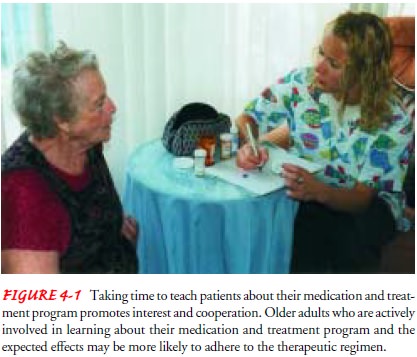Chapter: Medical Surgical Nursing: Health Education and Health Promotion
Adherence to the Therapeutic Regimen
Adherence to the Therapeutic Regimen
One of the goals of
patient education is to encourage people to ad-here to their therapeutic
regimen. Adherence to a therapeutic reg-imen usually requires that the person
make one or more lifestyle changes to carry out specific activities that
promote and maintain health. Common examples of behaviors facilitating health
include taking prescribed medications, maintaining a healthy diet, in-creasing
daily activities and exercise, self-monitoring for signs and symptoms of
illness, practicing specific hygienic measures, seeking periodic health
evaluations, and performing other therapeutic and preventive measures. The fact
that many people do not adhere to their prescribed regimens cannot be ignored
or minimized; rates of adherence are generally low, especially when the
regimens are com-plex or of long duration.
Nonadherence to prescribed therapy has been the subject of many studies. For the most part, the findings have been incon-clusive, and no one predominant causative factor has been found. Instead, a wide range of variables appears to influence the degree of adherence:
• Demographic variables, such as age, gender, race, socio-economic status, and level of education
• Illness variables, such as the severity of the illness and the re-lief of symptoms afforded by the therapy
• Therapeutic regimen variables, such as the complexity of the regimen and uncomfortable side effects
• Psychosocial variables, such as intelligence, availability of significant and supportive people (especially family mem-bers), attitudes toward health professionals, acceptance or denial of illness, and religious or cultural beliefs
• Financial variables, especially the direct and indirect costs associated with a prescribed regimen
The nurse’s success with health education is determined by ongoing assessment of the variables affecting the patient’s capac-ity to adopt specific behaviors, to obtain resources, and to main-tain a helpful social environment (Murray & Zentner, 2001). Teaching programs are more likely to succeed if the variables af-fecting the patient’s adherence are identified and considered in the teaching plan.
The problem of
nonadherence to therapeutic regimens is a substantial one that must be remedied
before patients can achieve their maximum self-care capabilities and health
potential. Sur-prisingly, a patient’s need for knowledge has not been found to
be a sufficient stimulus for acquiring knowledge and thereby en-abling complete
adherence to a health regimen. Teaching pro-grams directed toward stimulating
patient motivation produce varying degrees of adherence. The variables of
choice, establish-ment of mutual goals, and the quality of the patient–provider
re-lationship directly influence the behavioral changes that can result from
patient education (Rankin & Stallings, 2000). These factors are directly
linked to motivation for learning.
Using a learning
contract can also be a motivator for learning. Such a contract is based on the
assessment of patient needs, health care data, and specific, measurable goals
(Redman, 2000). A well-designed learning contract is realistic and positive; it
also includes measurable goals, with a specific time frame and reward system
for goal achievement. The learning contract is recorded in writ-ing and
contains methods for ongoing evaluation.
The value of the
contract lies in its clarity, specific delineation of what is to be
accomplished, and usefulness for evaluating be-havioral change. In a typical
learning contract, a series of goals is established, beginning with small,
easily attainable objectives and progressing to more advanced goals. Frequent,
positive rein-forcement is provided
as the person moves from one goal to thenext. An example of incremental goals
would be a weight reduc-tion program based on losing 1 to 2 pounds per week
rather than one that merely identifies a general goal of losing 30 pounds.
Gerontologic Considerations
Nonadherence to
therapeutic regimens is a significant problem for elderly people, leading to
increased morbidity and mortality and increased cost of treatment (U.S. Public
Health Service, 2000). Many nursing home admissions and hospital admissions are
linked to nonadherence.
Elderly people
frequently have one or more chronic illnesses that are managed with numerous
medications and complicated by periodic acute episodes. Elderly people may also
have other prob-lems that affect adherence to therapeutic regimens, such as
in-creased sensitivity to medications and their side effects, difficulty in
adjusting to change and stress, financial constraints, forgetful-ness,
inadequate support systems, lifetime habits of self-treatment with over-the-counter
medications, visual and hearing impair-ments, and mobility limitations. To
promote adherence among the elderly, time and effort must be taken to assess
all variables that may affect health behavior (Fig. 4-1). The nurse must also
con-sider that cognitive deficiencies may be manifested by the elderly person’s
inability to draw inferences, apply information, or un-derstand the major
teaching points (Eliopoulos, 2000). The pa-tient’s strengths and limitations
must be assessed in order to use existing strengths to compensate for
limitations. Above all, health care professionals must work together to provide
continuous, co-ordinated care; otherwise, the efforts of one health care
profes-sional may be negated by those of another.

Related Topics